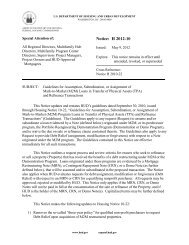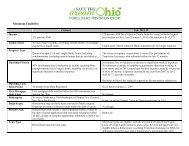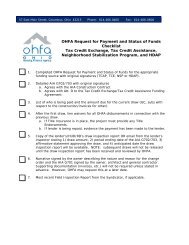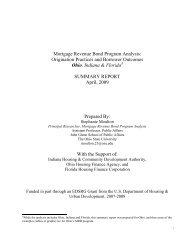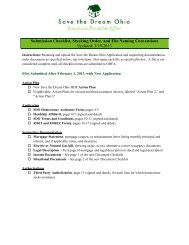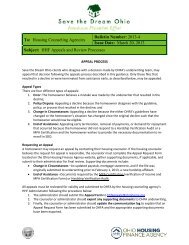lis 217 stemming the tide - LISC
lis 217 stemming the tide - LISC
lis 217 stemming the tide - LISC
- No tags were found...
Create successful ePaper yourself
Turn your PDF publications into a flip-book with our unique Google optimized e-Paper software.
chapter threeState and Local Preservation Tools and StrategiesSince <strong>the</strong> termination of <strong>the</strong> LIHPRHA and ELIH-PA programs, responsibility for preserving HUDassistedhousing has increasingly devolved to<strong>the</strong> state and local level. Today's federal preservationtools—including Enhanced Vouchers,Mark-Up-to-Market/Budget, IRP Decoupling,and Mark-to-Market incentives—are not adequatelydesigned or funded to preserve all of<strong>the</strong> units that remain at-risk. Not surprisingly,mortgage prepayments and opt-outs continueto erode <strong>the</strong> assisted housing stock.In recent years, however, a variety of innovativepreservation tools and strategies have emergedat <strong>the</strong> state and local level to supplement, andextend <strong>the</strong> reach of, existing federal programs.This chapter will review <strong>the</strong> laws, programs, andpolicies that have been developed by preservationadvocates, practitioners, and governmentofficials to preserve subsidized housing in <strong>the</strong>ircommunities. Both regulatory and incentiveapproaches ("carrots and sticks") will beaddressed. Case studies will illustrate how differentcommunities have combined <strong>the</strong>se toolsto develop successful preservation strategies. 301. REGULATORY ANDINCENTIVE APPROACHESRegulatory/Enforcement ToolsCrafting effective state or local regulatoryapproaches to preservation can be difficult.Efforts to restrict property rights must be carefullydesigned to avoid legal challenge. In <strong>the</strong>absence of funding or o<strong>the</strong>r incentives, permanentpreservation can rarely be accomp<strong>lis</strong>hedby state or local regulation alone. Never<strong>the</strong>less,a variety of regulatory and enforcement toolshave been utilized to bring owners to <strong>the</strong> negotiatingtable or o<strong>the</strong>rwise facilitate preservationoutcomes.Rent and Eviction ControlsSome localities have existing rent control laws(San Francisco, Los Angeles, New York City) orproposed initiatives (Massachusetts) that canhelp to preserve at-risk properties. These lawstypically extend coverage to federally-assistedhousing when <strong>the</strong> HUD subsidy expires throughmortgage prepayment or opt-out. Eviction controlsusually provide that tenancies in controlledproperties can be terminated only forgood cause.Where <strong>the</strong> regulatory scheme keeps rents belowmarket, incentives for conversion may be significantlyreduced. In San Francisco, for example,advocates attribute <strong>the</strong> virtual absence of prepaymentsand opt-outs to <strong>the</strong> city’s strong rentcontrol system. A weaker or more transitory regulatoryscheme may have less of an impact. At<strong>the</strong> same time, rent controls that depress propertyvalues below <strong>the</strong> level required to cover <strong>the</strong>seller's exit taxes 31 may discourage ownershiptransfers, including sales to nonprofit purchasers.For this reason, some preservationadvocates have sought to exempt propertiessold to nonprofits from rent control coverage.Existing Use RestrictionsSome properties may have use restrictionsimposed by a state or local agency that dateback to <strong>the</strong>ir original development. Theserestrictions often limit a property’s use beyond<strong>the</strong> expiration of federal regulatory agreements.Local restrictions commonly arise from urbanrenewal plans, land disposition agreements,zoning or parking relief, tax relief, or publicfinancing.Often <strong>the</strong>se covenants are buried in long-forgottenlegal documents, and identifying, excavating,and interpreting <strong>the</strong>m in a way that ismeaningful to current circumstances can be aformidable challenge. But <strong>the</strong> rewards can besignificant: in Massachusetts, enforcement ofexisting restrictions by state and local agencieshas resulted in significant preservation benefits(see below).Notice RequirementsA number of states (California, Minnesota,Maryland) and cities (Portland, Oregon; SanFrancisco, California; Denver, Colorado) havelaws that supplement existing federal notice22chapter three: State and Local Preservation Tools and Strategies



